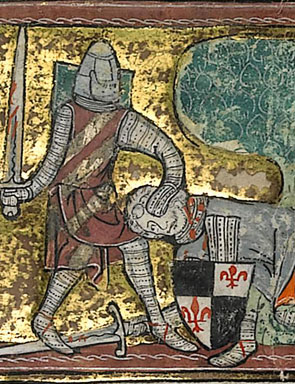
"Rouchefoucauld Grail" (detail), 1315-1323, Sotheby's, London
Wow. So how often does something like this go to auction? No, it’s not THE Grail, but in the world of medieval codicology (the study of books as physical objects) this is THEIR grail. The Rouchefoucauld Grail (c. 1315-1323) is considered to be the oldest surviving account of the Arthur’s quest for the Grail. From ArtDaily:
It is the greatest romance of chivalry produced in the Middle Ages, and its themes of friendship, treachery, ambition, achievement and star-crossed tragic lovers form the foundations of much of our modern literature. The stories of the quest for the Holy Grail, of the Lady of the Lake, of King Arthur and his court at Camelot, and of Sir Lancelot and Queen Guinevere, captured the imaginations of generations to come, and have inspired some of the best-selling novels of our time. The Rochefoucauld Grail is from the 14th century, and on a scale which is as impressive as the text: some 200 cows would have been needed to produce the vellum sheets that make up the three monumental volumes, the whole embellished with some 107 jewel like illuminated illustrations – each one a work of art in its own right.
Dr Timothy Bolton, specialist in charge of the sale at Sotheby’s, said: “This is one of the principal manuscripts of the first significant medieval work of secular literature. It is a grand book, in a monumental format, with 107 miniatures, each a dazzling jewel of early gothic illumination. The subjects are almost entirely secular – a breathtakingly unusual thing at the time – with scenes of jousts, tournaments and battles, noble adventures and daring tests of strength and courage. The scenes often have a riotous energy, and often stretch beyond the boundaries of the picture frames, with lofty towers poking through the borders at the top, and figures tumbling out of the miniatures onto the blank page as they fall or scramble to escape their enemies.”
To check out the parchment’s specs (or to register for the auction) click here. Just keep in mind it may go for around $3.2 million. If that’s a little out of your price range though, I’ll settle for any of these.












